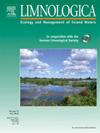Ecological risk assessment of the impact of trace metal contamination on the benthic fauna and sediment of River Siluko, Edo State, Nigeria
IF 2
4区 环境科学与生态学
Q2 LIMNOLOGY
引用次数: 0
Abstract
This study evaluated the potential ecological and human health risk of trace metal pollution in sediment and benthic fauna (Pila ampullacea) of River Siluko. Result showed trace metal contamination of both sediment and P. ampullacea, with concentration profile of Fe > Zn > Cu > Cr > Mn > Co > Ni > Pb in sediments, and Fe > Zn > Cu > Mn > Ni > Co > Cr > Pb in P. ampullacea. Contamination factor values for Zn, Cu, Mn, Cr, Co, Ni and Pb were of low degree contamination (CF < 1) and Fe was of very high degree of contamination (CF > 6). The contamination degree (CD) values of the study Stations indicate a very high degree of sediment contamination from trace metals (CD ≥ 24). Potential ecological risk index (PERI) values classified the study stations 1, 2, 3 and 4 as of low ecological risk (PERI ≤ 150). Toxic Response Index Values (TRI) indicate no risk to aquatic organisms (TRI ≤ 5). Human health risk assessment associated with the consumption of contaminated P. ampullacea indicated non – carcinogenic risk (HI > 1) and carcinogenic risks to consumers, as the integrated carcinogenic risk (ICR) value classified the consumption of the edible part of P. ampullacea as extremely high risk (Grade VII) to consumers. The need for exigent actions to be taken in the abatement and regulation of identified anthropogenic activities responsible for the release of these metals into River Siluko is recommended.
痕量金属污染对尼日利亚江户州Siluko河底栖动物和沉积物影响的生态风险评估
本研究评价了丝鲁科河沉积物和底栖动物中痕量金属污染的潜在生态和人类健康风险。结果显示微量金属污染的沉积物和p . ampullacea浓度剖面的Fe祝辞 锌祝辞 铜祝辞 Cr祝辞 Mn祝辞 公司祝辞 倪祝辞 Pb在沉积物和菲比; 锌祝辞 铜祝辞 Mn祝辞 倪祝辞 公司祝辞 Cr祝辞 p . ampullacea Pb。Zn、Cu、Mn、Cr、Co、Ni、Pb污染系数值为低污染程度(CF < 1), Fe污染系数值为高污染程度(CF > 6)。各监测站的污染程度(CD)值表明沉积物受微量金属污染的程度非常高(CD≥24)。潜在生态风险指数(PERI)将1、2、3、4站划分为低生态风险(PERI≤150)。毒性反应指数(TRI)提示对水生生物无风险(TRI≤5)。食用受污染的壶形参的人类健康风险评估显示,消费者存在非致癌风险(HI > 1)和致癌风险,因为综合致癌风险(ICR)值将消费者食用壶形参的可食用部分划分为极高风险(VII级)。建议有必要采取紧急行动,减少和管制已查明的导致这些金属排放到锡卢科河的人为活动。
本文章由计算机程序翻译,如有差异,请以英文原文为准。
求助全文
约1分钟内获得全文
求助全文
来源期刊

Limnologica
环境科学-湖沼学
CiteScore
3.70
自引率
5.90%
发文量
64
审稿时长
3 months
期刊介绍:
Limnologica is a primary journal for limnologists, aquatic ecologists, freshwater biologists, restoration ecologists and ecotoxicologists working with freshwater habitats.
 求助内容:
求助内容: 应助结果提醒方式:
应助结果提醒方式:


